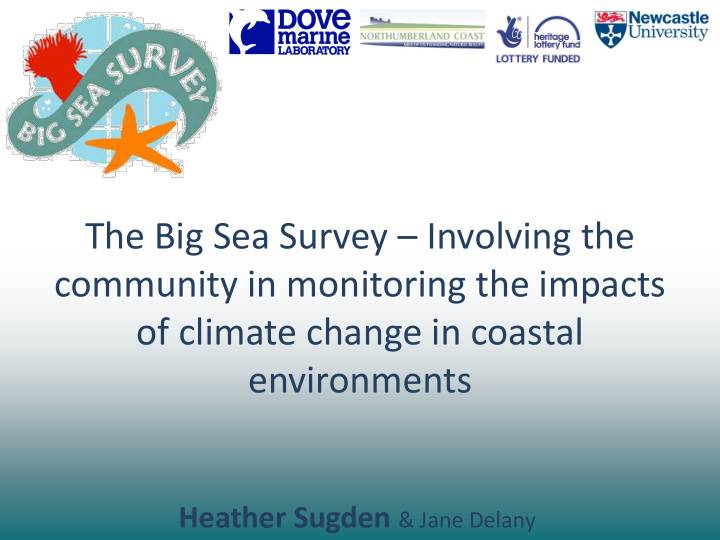



The Big Sea Survey – Involving the community in monitoring the impacts of climate change in coastal environments Heather Sugden & Jane Delany
Contents Background to the Project Aims What is it all about Case Study – The Durham Coast So Far, So Good What’s Next
Background to the Project
Background to Project There is also a cultural heritage inherent in people’s knowledge and identification with the seas and coasts of the region.
Background to Project Despite this rich heritage A UNIFIED AND COMPREHENSIVE AUDIT OF MARINE INTERTIDAL ORGANISMS DID NOT EXIST IN THE REGION This is essential if ecological change is to be readily detected
Background to the Project Loss of biodiversity
Background to Project The lack of baseline is especially pertinent in our region due the biogeographic boundary upon which the UK and especially the north east sits. Gibbula umbilicalis Chthamalus montagui Osilinus lineatus Balanus perforatus Forbes, 1858. A.K. Johnson’s Physical Atlas. Hawkins et al 2009: Results from the MarClim project
Aims of the Project 1.Recruitment of 150 volunteers 2.Awareness of coastal biodiversity 3.Awareness of marine issues 4.Heritage 5.Training and skills 6. Baseline dataset and species records 7. Coastal indicators of change
What’s it all about? A. Individual Surveys B. Mini Research Projects C. Big Biodiversity Days
Statistics Aim 1 – Recruit 150 volunteers Big Sea Survey began May 2010 3 year project funded by Heritage Lottery Foundation Some additional funds from Northumberland AONB and Durham Heritage Coast Nearly at completion – 4 months to go with additional funding until end of April Trained 357 volunteers in the project, 249 (70%) continuing to take part MAINTAINED RETENTION RATE 190 volunteers with kit out surveying MORE DATA BEING SENT IN – Building a fantastic picture of the coast
Training Aims 2-5 – Awareness of coastal biodiversity, marine issues, heritage, training and skills Hosted 14 training days Intensive days including lectures, field work and laboratory sessions One in Saltburn One in St. Abbs Continuing to train individuals where there is demand One to one Some additional training on species ID Field support to help with in the field ID and survey techniques – DATA ON ROBUSTNESS Wine & Science
So far, So good Urchins at Eyemouth Invasive green seaweed, painted top shell (first record in 15 years) and a population of stalked jelly fish (again first seen in 15 years) at Beadnell Anemones at Howick Dabberlocks at Seaton Sluice new southern range limit Octopus at Boulmer Green sea urchin at Cullercoats – first recorded in over 10 years Dhalia anemones at Blackhall Rocks
Baseline Data & Species Records Aim 6 – Species Records One of the main aims of the project 134, 590 presence / absence records for the region NEW SPECIES RECORDS FOR THE REGION Rare species being recorded & monitored Really good spread of data across the region Diversity trends from north to south
Baseline Data & Species Records Aim 6 – Species Records 134,590 presence / absence records British Trust for Ornithology – 50 years of data 40,000 volunteers 7.5 million records from 2007-11 for Bird Atlas ‘long-term monitoring data on status of UK birds sets the standard for understanding the effects of environmental change worldwide’ Seasearch – 25 years > 42,000 records in 2011 843 Species in 2011 4 books
Coastal Indicators of Change Aim 7 – Coastal Indicators Meaningful data for the region Achieved through specific ‘mini projects’ Huge success linking these projects with global and national organisations Great participation
So far, So good
So far, So good 5 4.5 4 3.5 Species Diversity (H’) 3 Saltburn 2.5 Creswell Beadnell 2 1.5 1 0.5 0 Winter Spring Summer Autumn Season
Case Study: The Durham Coast • Assessing the species diversity on the shores here • Using volunteer data • Using a broad-scale search of the area to identify all species present on each shore • Data will look at how the shores of the area are recovering • We will look at other polluted areas, for example Lynemouth • We will look at areas where there has been little pollution
The Durham Coast 55 35 29 Closed 1966 40 30 24 Closed 1993 Closed 1981
The Durham Coast 60 50 40 Number of Species 30 20 10 0 Easington Colliery Nose's Point Seaham Harbour Ryhope Hallywell Ryhope Village North Salterfen
The Durham Coast
What’s next • Continue surveying for the next 4 months & work up data from all our projects • Assess the benefits to volunteers –results show a greater advocacy of intertidal areas and a more in depth understanding of ecological processes • Big Sea Survey Book – Field Guide, Species Guide and Shore Guide • Celebration Event • Further funding – Big Sea 2
Thank you for listening Any Questions? Contact: Heather Sugden, 01912223059 bigseasurvey@ncl.ac.uk
“ The Big Sea Survey allows me to experience my visits to the coast on a whole new level as I now have a much better understanding of the species that live there and how they interact with each other. The project is also helping me on a professional level and is making a really valuable contribution to the skills resource in the region.” Claire Hedley, European Marine Site Officer
Recommend
More recommend